(Ross Gibson, Seven Versions of an Australian Badland, University of Queensland Press, 2002, p179)
I've blogged before about where I feel at home, and why. I'm now a dedicated city person; but I grew up inland, and the landscapes of inland NSW still tug at my heart. I know the shape and feel of small country towns and I appreciate the generations of work and hardship, as well as community-building, that went into shaping them. On my recent road trip I was particularly aware of the efforts that are being made to preserve, sensitively, marks of the ebb and flow of white settlement over the last two centuries. The trick is to do this in ways that don't undermine recognition of ancient Aboriginal ownership.
So, in vaguely chronological order, some of my favorite 'marks':
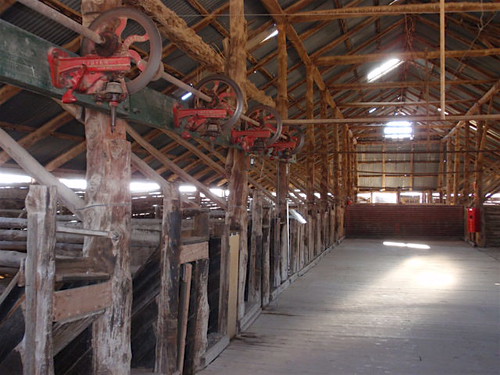
The shearing shed (1870) on Mungo station, on the western edge of Lake Mungo. The pastoral lease on Mungo station lasted from the 1860s through to the 1960s - mostly in the same family. The ultimate futility of trying to graze this country is very evident in these dry times, but nevertheless, you marvel at the persevering spirit of those who braved the isolation and hardship of farming this land.
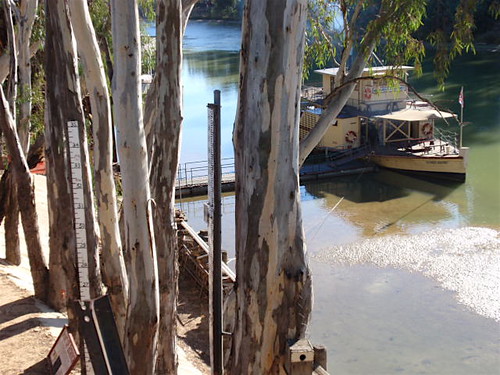

The paddle steamers at Echuca and the old gaol at Wentworth. In different ways, these both mark the period from about 1870 to 1910 when the river trade on the Murray, Darling and Murrumbidgee Rivers was vital to the pastoral industry and trade in south-east Australia. The gaol at Wentworth, at the confluence of the Darling and Murray Rivers, was built to deal with the population boom of frequently law-offending riverboat men, dock-workers, shearers and itinerant laborers who were attracted by the port. By 1920, when railways supplanted the riverboats and the population shifted to towns served by the railways, the riverboats were largely abandoned and the gaol was closed for lack of prisoners.
The gaol at Wentworth had cells for both men and women. According to the story told there, most of the women prisoners were members of the Salvation Army, who, in the late nineteenth century were regarded as members of a dangerous sect, often disturbing the peace by speaking in public of many of the evils of Wentworthian behaviour.
From this same period come many of the wonderful country hotels:

I love the mellow red brick used in this old pub in Echuca and in so many of the late nineteenth century buildings (including the Wentworth gaol) in these river regions.
By the late nineteenth century many railways, and the companion railway stations, were built. My friend Jan has great difficulty passing up a chance to visit anything associated with railways, so on this trip we managed three railway stations - Junee, Hay and Narrandera - and a railway turntable at Junee (don't ask). Like the riverboats before them, the railway's day of glory has past, and of these only Junee (built 1883) is still used as a station
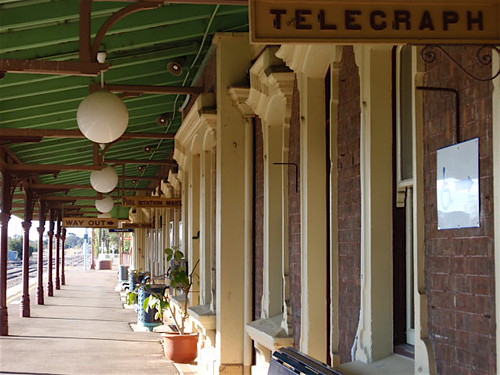

Not only the station, but the associated railway buildings around the entrance square are in the elegant Italianate style often used for railway buildings. Nowadays, when beautiful public buildings such as post offices and banks are being sold off willy nilly, it's interesting to register the level of pride that was once taken in these lovely public spaces.
The railway station at Hay, by the way, has an amateur but moving museum to Hay's role as an internment and POW centre during the Second World War, when the population of this isolated town doubled because of the camps.
We had a bit of a diversion from the rivers to visit Leeton and Griffith - towns that were newly built in the 1920s within the Murrumbidgee Irrigation Area. They were created at a time when irrigation was seen as the miraculous greening of a barren Australia - before the damage from salinity and the limits to the water supply were realised. I was newly surprised to be reminded that these two towns, with their circular street layouts, were designed by Walter Burley Griffin - the designer of Canberra. They are so different from the nineteenth century colonial towns. They have moved away from the typical grid layout and their public buildings are in art deco style, as is the remarkable (and still surviving) Roxy Theatre in Leeton (1929).

Perhaps even more remarkable is that for the first decade or so of their existence alcohol was prohibited!
But possibly my favorite Walter Burley Griffin structure is the first of three watertowers in Leeton, with its elegant decorated top edging. Two later towers were designed to match. I have a weakness for watertowers, and it made my day to discover such an elegant practical structure with wonderful design provenance (I'm easily pleased!)
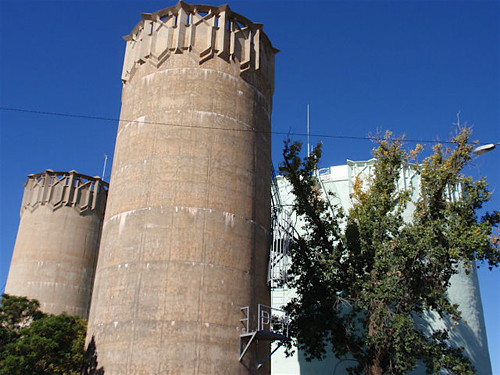
And finally, a modern-day colonnade in Mildura, roofed with autumn-toned vines. You probably can't quite see one of the signs in the colonnade, but it reads 'Stefano's'. Yes, we did have a superb five course dinner at Stefano de Pieri's restaurant - fresh produce, perfectly prepared and elegantly restrained.
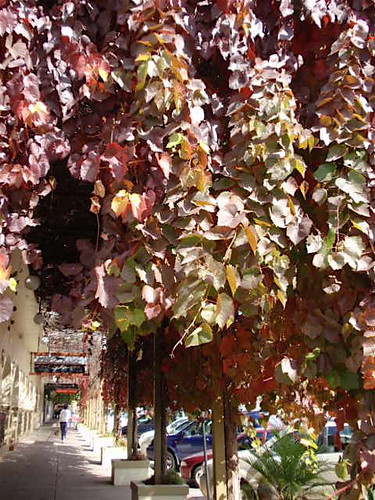
Finding the marks of our past and present lives in buildings and streets is the perfect focus for a local holiday.
7 comments:
I did not know that WBG designed Griffith and Leeton - how embarrassing to be from a town so close to them and not know about that!! (our school excursion to Griffith focused on the irrigation and wineries!!)
As always, great pictures and I love your perspective.
Again, lovely photos - thanks for sharing.
And like RR, I didn't know WBG designed those two towns - I've been to both of them too!
Check this link - it is the Roxy Theatre [still in use] in the town where my parents live. Roxy must have been the theatre title of the 20s! [there was one in Parramatta too]http://travel.webshots.com/photo/1151855606055856927nrzbZd
What a great holiday Lyn and thankyou for sharing your travels.
I love Griffith and spent a week during the course of my studies measuring up the 1km length of the main street - to which we then designed a town plan to encompass the exisiting layout. It was a long week. I also remember those watertowers - they are truely gorgeous and I wish the power station at Pyrmont was still there - proof that utilites need not be ugly
Wonderful photographs supporting a fascinating contemplation of the impact Europeans have had on a landscape in such a relatively short time.
fantastic stories, great photos. i can only imagine how scrummy stefano's was!
Lyn, thank you so much for these posts. I wish I'd had time to travel inland much (at all) in NSW - we did a bit in the SW of WA, which was lovely, but... I remember very much enjoying the Oodnadatta track in SA/NT 11 years ago, and would have loved to expand on that experience.
That's what comes of having a partner obsessed by the sea.
What a wonderful series of photos and reflections. Lovely. Country Australia really does offer up so much wonderful history and to see it being preserved, sensitively, is a marvel.
Post a Comment